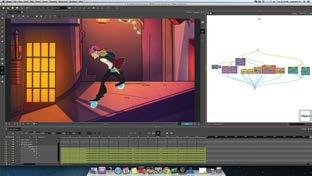previous page
ISSUE
TOC
250
V isual E ffects
Serious Assembly Required ILM and Trixter spearhead the complex mo-cap, animation and effects wizardry that required 19 facilities to make Marvel’s Avengers: Age of Ultron. By Tom McLean.
T
he stakes are higher, the action bigger and the visual-effects challenges off the charts as Marvel Studios re-assembles its A-list team of superheroes for Avengers: Age of Ultron. The second Avengers feature sees the team facing Ultron, an artificial-intelligence-based global-defense system created by Tony Stark (Robert Downey Jr.) and Bruce Banner (Mark Ruffalo), that becomes conscious and rebels against its creators. Played by James Spader via motion capture and animation, Ultron morphs from an amalgam of Stark’s Iron Legionnaires into an imposingly huge robot bent on destroying humanity. In resisting Ultron, the Avengers are joined by the sibling threats-turned-heroes Quicksilver (Aaron Taylor-Johnson) and Scarlet Witch (Elizabeth Olsen), in a massive showdown in their native European country of Sokovia. Again written and directed by Joss Whedon, Avengers: Age of Ultron was a hugely complicated movie that required 19 visual-effects companies to complete. The bulk of the effects — some 800 shots — were handled by Industrial Light & Magic, which ILM senior visual-effects supervisor Ben Snow says was one of the few facilities Marvel’s production visual-effects supervisor Chris Townsend trusted to deliver on the movie’s most complicated and difficult sequences. Among the sequences ILM tackled are the Avengers’ opening battle with Strucker; Iron Man’s dream sequence of the Avengers defeated; Ultron Prime; the freighter battle; the Hulk, including the Hulkbuster sequence; and the fi-
ILM found ways to improve even further upon its digital version of the Hulk, above. ILM’s Ben Snow says the Hulkbuster design was a joy to work with. Opposite at top: Sokovia rises. Opposite below: The villain reaches his final state as Ultron Prime.
nal battle in and over Sokovia. Created by writer Roy Thomas and artist John Buscema and debuting in 1968 in the pages of Avengers #54 and #55, Ultron’s first on-screen appearance was handled by Munich-based Trixter, which had done animation work for Marvel previously on Iron Man 3. Trixter visual-effects supervisor Alessandro Cioffi says they had an advantage by starting on the project early, having been asked in early 2014 to work on Ultron Mark I in time for the character to debut in a presentation at last year’s Comic-Con. “We were presented with an original design from Marvel for Ultron Mark I, but … it was rather sketchy and needed some translation into the real world,” says Cioffi.
Origins Origins of of Ultron Ultron Ultron starts the story as a software system and assembles a physical form from various parts of battle-damaged Iron Legionnaires and old Iron Man armor. Trixter worked on an asymmetrical figure with moving parts, hanging cables and leaking oil to create a creepy look for the character. Then Trixter added Spader’s performance, which was recorded by Andy Serkis’ London-based Imaginarium motion-capture studio. Trixter’s animation supervisor Simone Kraus says they delivered an early version of Ultron Mark I with an animation rig to Imaginarium, which set up a mo-cap stage near London at Shepperton Studios, where the movie was shooting. With a few weeks to work exclusively on the motion capture,
78 www.animationmagazine.net june 15
TOC
previous page


















